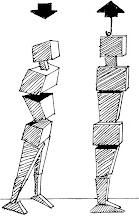"Why is Rolfing so painfull?" When I see a new client I often hear about Rolfing's painfull repuatation. This may be due to the nature of the therapy, people's expectations around Rolfing, and the communication that happens during a session. Fundamentally the pain happens when nerves are stimulated.
THE NATURE OF ROLFING
The nature of myofascial release work - and Rolfing therapy - is one that creates a deep and lasting change for the client. This said, the depth of the work, and the speed at which the tissue changes are two key components of the pain level experienced within the therapy. If I jump into your quadricep with my elbow, and start pushing hard and fast - that will create a lot of pain (unless you're particularly thick skinned). However, if I address outer layers of myofascia first, and unravel the tissue on different layers (outer to inner) with a slower approach the you will NOT experience much pain/neuro sensory overload.
This said, Rolfing isn't for the faint hearted (unless you found a particularly patient and unique practitioner). Tissue change is challenging, and I liken it to deep psychological work. Sometimes it feels great, and sometimes it just sucks. We go to therapy because we have problems, and want to elevate our overall quality of being/existence. A good therapist (whether myofascial release, deep tissue massage, Rolfing practitioner, chiropractor, etc.) will know your limits, know how to manage your pain level and not let it get out of control to the point where you just don't want to come back. A key question in deciding whether Rolfing is for you is deciding if want to confront the ingrained reality of inflexibility in your body. If this is true, a happy medium can be found. However, like talk therapy, sometimes the confrontation of self can be too much. Rolfing can end up feeling like a trap that you just want to get out of, and for that we need to allow agentle, kind, patient, loving presence in our work. I strive to provide this on balance to my clients and utilitze to outer to inner approach to unraveling as much as is possible in order to create a wholly satisfying, yet transformational client experience.
COMMUNICATION IN ROLFING
A key component in Rolfing is direct communication between client and therapist about the pain level, moderation of the level, and a mutual sense of satisfaction around this. Rolfers are not masochists or sadists. We care about helping people, creating new alignment, better posture, improved breathing, freedom from chronic pain and myofascial restriction, transformation in life, and many other things. For this reason, I am typically very direct with clients about the pain level in the session. A number scale is a quick and dirty way to find out where the client is with the therapy - "1 is nothing, 10 is excruciating, I never want to go above a 7 or 8 for you during the session, so please let me know if I'm getting there" is a typical statement I make to my clients when I first meet them, and during our first session I make a point of using this system a couple times so they get a good feel for it.
With the 1-10 scale in place, direct communication can still be still elusive. For this I typically watch breathing patterns (restricting breath can mean pain), and facial grimacing. Nonetheless, clients can withold their expression of pain, hide it from the practitioner, and go away feeling it was too much. Creating a promise to the client to moderate pressure and approach according to pain/sensation threshold is only as good as the client's expression of his/her threshold. Trust on the Rolfing table is not an easy thing to come by, especially if you have difficulty expressing your limits in day to day activity, or with your body in general. So Rolfing is not something I would recommend to people who struggle greatly in this area. Or if they do -to consider Rolfing but only with the open discussion of this boundary issue with your therapist. There are truly great moments in Rolfing when the client - choosing to face his/her inflexibility in an area can find great satisfaction, trust, and relief in literally handing his/her body over. This is built on trust with the practitioner, and trust of self. It intimate but not sexual. It is simply a state of being safe, met, and realized. For me, these are some of the finest moments in my practice.
skip to main |
skip to sidebar

San Francisco's Certified Rolfer and Registered Nurse, Greg Brynelson, blogs his thoughts and events to clients, and interested people about Rolfing, his practice, and more.
About Greg
- Greg Brynelson
- San Francisco, CA, United States
- In 2002 Greg became a Certified Rolfing practitioner. His active career as a nurse and background as a sculptor, sweedish massage therapist, and yoga teacher inform his approach to Rolfing Structural Integration.

Blog Archive
Labels
- alternative medicine (4)
- anatomy (1)
- back pain (2)
- california (1)
- carpal tunnel (1)
- charity (1)
- chiropractic (1)
- complementary care (3)
- deep tissue work (2)
- desk posture (1)
- detox (1)
- diet (1)
- discount (1)
- energy (1)
- ergonomics (2)
- eye strain (1)
- fast (1)
- free (1)
- gift (1)
- giving (1)
- health stategy (1)
- healthcare (1)
- high heels (1)
- human (1)
- ida rolf (2)
- massage (3)
- medicine (1)
- mind (1)
- myofascia (3)
- myofascial release (2)
- naturopathy (1)
- neck pain (1)
- pain (1)
- pilates (1)
- posture (3)
- preventive medicine (1)
- promotion (1)
- psyche (1)
- purse (1)
- rolfer (3)
- rolfing (8)
- san francisco (1)
- slouch (1)
- touch (1)
- vertebrae (1)
- weight loss (1)
- woman (1)
- yoga (2)



